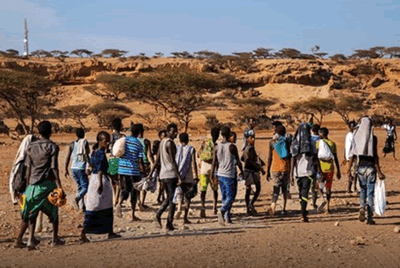Common misconceptions about African migration?
Written by Paul Akiwumi, Division for Africa, Least Developed Countries and Special Programmes, UNCTAD
For millions of African migrants and their families – like others worldwide – moving to another country offers a chance for a better life with benefits extending to future generations.
Yet beliefs about international African migration are rife with misconceptions that have become part of a divisive, misleading and harmful narrative.
More and more, migrants in destination countries have become victims of violence, xenophobia and other forms of abuse due to faulty thinking and often inaccurate information about migration.
But at the United Nations, we still believe facts are important. Accurate, objective information about migration is essential for dispelling misconceptions and informing policy decisions.
In December, the Compact on Migration – the first intergovernmental agreement prepared by the United Nations covering all dimensions of global migration – will result in a resolution to be put forward to the UN General Assembly.

As consultations on the Compact continue, establishing the evidence about international African migration and shattering common myths is important.
Perhaps first among these is the idea that most Africans are leaving the continent for Europe.
Images of young Africans attempting to cross the Mediterranean Sea, while vivid and real, paint a misleading picture. Recent evidence suggests that international African migration is mostly an intra-African phenomenon.
Last year, of an estimated 41.5 million people counted as international migrants from, to, or within Africa, 19 million remained on the continent, 17 million were resident outside of the continent and 5.5 million were immigrants from the rest of the world. For those who left Africa, Europe was far from the only destination, according to new research in the Economic Development in Africa Report 2018, published this month by my organization, the United Nations Conference on Trade and Development (UNCTAD).
In East, Central and West Africa, more than 80% of international migrants were from the same region, the report says, underscoring the intra-regional nature of migration on the continent.
A second myth maintains that migration contributes to unemployment in destination countries. Migration can exert additional pressure in destinations with high unemployment but migration itself, the report finds, is not associated with a rise in unemployment in destination economies.
In fact, in countries and regions where migration is properly managed, migrants moving in response to market demands for skills often fill critical gaps and enable non-migrants to pursue higher value work.
Thirdly, it is often believed that migrants depress wages. Rising employment from migration does, in theory, pressure wages in the medium term. But in reality most African economies are relatively homogeneous so wage differences between workers from origin and destination countries are often small. The wage-depressing effect in destination countries is therefore likely to be minimal.
A fourth myth: migration contributes to increased pressure on public spending for basic services. Immigration in Africa is, however, not necessarily linked to increased public spending in health. In fact, migrants are likely to cover their own health costs and, importantly, increased immigration in Africa occurs in parallel with improvements in education and health – especially for women.
Finally, many people think that migration is harmful to origin countries.
To be sure, migration has benefits and risks for both origin and destination countries. The loss of tax revenues and skilled labour – particularly in Africa’s poorest countries and developing islands – poses critical challenges for origin countries but the benefits derived from migration in some countries far outweigh the risks, the UNCTAD report reveals.
In addition to the substantial remittances that African migrants send home – the total of which has in recent years even surpassed all overseas aid to the continent – migration also stimulates trade, and in particular, food exports from origin countries.
The facts tell their own story.
As international migration in Africa continues to grow, the question is not whether people will move, but where they will move and under what circumstances and conditions.
To be a win-win for countries and migrants, safe, regular and orderly intra-African migration must be a priority. And there are signs that African governments are making it one.
This March, African Union member states inked the African Continental Free Trade Agreement – the beginnings of an African single market and 30 of them adopted the Protocol on free movement of persons. These follow the launch of a Single African Air Transport Market in January.
To build on these achievements, the UNCTAD report says that African countries can put in place flexible labour policies that allow migrants to move to and take advantage of economic opportunities in Africa’s regional markets. For instance, Rwanda’s temporary (H-4) visa for semi-skilled migrants, and the removal of preferences for Moroccan nationals for some jobs – both of which have enabled migrants to take up employment legally – are examples of good practices that could be adopted elsewhere.
Governments could also align migration, trade and investment policies with long-term development objectives to create the conditions necessary to spur further economic growth.
In addition, African countries can unlock the potential of commodity-based industrial value chains to boost growth and generate jobs, both for nationals and for migrants with the right skills set. And development partners can play a role in addressing structural barriers that hinder sectors with promising potential for industrial growth such as agriculture, services and manufacturing, including by investing more in infrastructure.
Lastly, intra-African migration will only benefit people if they can move between and within regions in a safe, orderly and regular fashion.
One clear way to do this would be to get the much-touted all-African passport off the ground and make the free movement of people on the continent a reality.
Read the original article on Theafricareport.com
Follow them: @theafricareport on Twitter | theafricareport on Facebook


